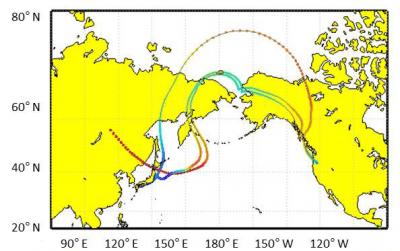
Microbes Hitch Rides Across Ocean on Dust Plumes

Thousands of species of microbes make the giant leap across the Pacific Ocean from Asia to North America by hitching rides on dust plumes high up in the atmosphere, a new study finds.
The findings, detailed in the December issue of the journal Applied and Environmental Microbiology, have implications for understanding the transport of both air pollutants and organisms, and could influence the way we view the atmosphere's relationship to Earth's life.
"I think we're getting close to calling the atmosphere an ecosystem," said lead author of the paper describing the research David J. Smith, who recently earned his PhD at the University of Washington. "Until recently, most people would refer to it as a conveyor belt, or a transient place where life moves through. But the discovery of so many cells potentially able to adapt to traveling long distances at high altitudes challenges the old classification."
Small life, small world
Smith and his colleagues sampled two large dust plumes that wafted over the ocean from Asia in spring of 2011 at Mount Bachelor in the Cascade Mountains of central Oregon, according to a university release. It's estimated that each year such dust plumes carry about 7.1 million tons of aerosols, tiny particles like dust, other pollutants and even microbes that are suspended in the air.
The team's initial search for microbes in the plumes relied on traditional methods of culturing these life forms, and found only 18 species. That work was published in July.But the scientists were able to gather enough DNA from the biological samples they took to apply more fine-tuned methods to analyze samples. These methods revealed a whopping 2,100 unique species in the plumes.
"It's a small world. Global wind circulation can move Earth's smallest types of life to just about anywhere," Smith said in a statement. [Tiny Grandeur: Stunning Photos of the Very Small]
Sign up for the Live Science daily newsletter now
Get the world’s most fascinating discoveries delivered straight to your inbox.
Of the microbes the team identified, about half were bacteria and half were fungi. Most of them originated from soils and were dead once they reached North America, according to the release. Most of the microbes also posed no threat to humans.
Many of the species traced by the study are found at low, background levels on the West Coast, but their numbers spiked when the plumes arrived. Because of this, the scientists likened the microbes to other forms of air pollution that are also present in the background, but that can become elevated during particular events.
"I was very surprised at the concentrations. One might expect the concentrations of cells to decrease with altitude based on fallout and dilution," Smith said. "But during these plume events, the atmosphere was pooling these cells just as it does with other kinds of air pollution."
Biological final frontier
Two of the three taxonomic families of bacteria that the scientists identified are known to adapt well to harsh conditions, such as those in the chilly upper troposphere, about 11 miles (18 kilometers) above the Earth's surface. These bacteria can form spores that allow them to essentially hibernate.
The scientists haven't seen much evidence for the growth of microbes when aloft, but the microbes can influence precipitation by acting as nuclei that water vapor can glom onto to form rain and snow. Other studies have estimated that microbes serve as the nuclei for about 30 percent of the world's precipitation, the release noted.
The scientists hope to sample the upper atmosphere for more such microbes, seeking a better understanding of how they interact with that harsh environment and how they might affect the global flow of life. But such efforts face challenges, the researchers note.
"Because it is so difficult to get samples, I argue it's probably the last biological environment on the planet to be explored," Smith said.
This story was provided by OurAmazingPlanet, a sister site to Live Science. Reach Andrea Thompson at athompson@techmedianetwork.com and follow her on twitter @AndreaTOAP. Follow OurAmazingPlanet on Twitter @OAPlanet. We're also on Facebook and Google+.

Andrea Thompson is an associate editor at Scientific American, where she covers sustainability, energy and the environment. Prior to that, she was a senior writer covering climate science at Climate Central and a reporter and editor at Live Science, where she primarily covered Earth science and the environment. She holds a graduate degree in science health and environmental reporting from New York University, as well as a bachelor of science and and masters of science in atmospheric chemistry from the Georgia Institute of Technology.









